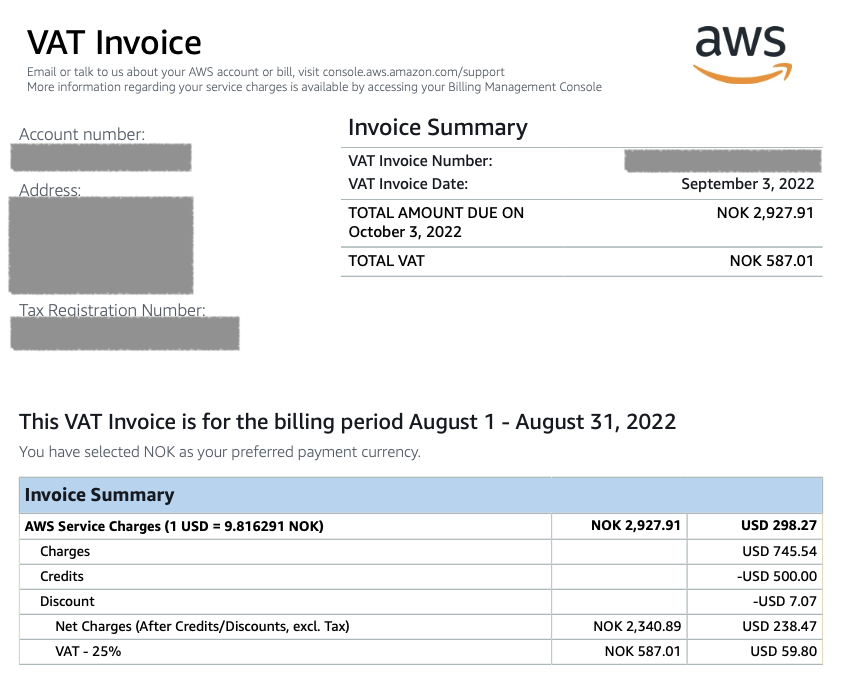AWS price and cost — billing
%20Aws-part2-cover.png)
(This is part 2 of a series of blog posts related to pricing and cost in AWS.)
Using AWS-services most likely means that you have to pay for them, or at least relate to the cost of using them (see part 1 for intro to cost). AWS invoices customers on a monthly basis based on the usage last month. The billing-cycle follows UTC and starts at the first second of the month, and AWS issues an invoice which you will have to pay.
Payments
For new AWS accounts there are in general only one way to pay your bill; you will have to add a credit card to your account.
Another option - if you are an established business - is to find an AWS-partner which can act as a reseller/proxy for you, and then you can get your AWS-invoice through them instead.
If you are using your credit card and have been running for some time, and your spend is growing from small to medium to large, you might be eligible to pay the invoice by bank (wire transfer) or by direct debit. Check the documentation for direct debit and talk to your AWS account-manager about wire-transfer.
USD is the default currency for the invoices. If you prefer you can switch to another supported currency. Note that this setting is in the “accounts”-page, not on the billing page.
The invoice will show all details in USD as well as the exchange rate and totals. The totals and the amount to pay will be in your chosen currency. The rate used is Amazon’s own rate at the time of invoicing, and might be the same or even better than your credit card company’s rate. You also can check today’s rate in the console when you switch currency if you would like to compare.
Invoices
AWS operates globally, which means they also have a lot of legal entities. Normally you will get one invoice from a “regional” AWS company for your usage. I am getting mine from Amazon Web Services EMEA SARL (AWS Europe). For some services AWS will issue a separate invoice from another company like Amazon Web Services Inc. (AWS Inc.). This has no big impact to you, except that you will have multiple payments and invoices and not one for each month.
AWS invoices are visible and possible to download in the console. You can also get them via email as soon as they are ready at the start of each month (normally during day 2–4 of the month). Set up email-alerts (with or without PDF from day one) — see documentation.
Depending on your location and account settings you will get a legal VAT-invoice from AWS, which you can use in your accounting system. One important thing to remember is to set the correct tax information in your account from the start. This can save you (or your accountant) some work with reversed VAT later. If you do not add tax info, AWS will collect the local sales tax in your country and you will have to sort things out later.

(Sample: Invoice in NOK from AWS Europe payable by bank)
In the billing console you also have a page with payments due, payment transactions etc.
Understanding your bill
Spend some time reading your bill in the console or in the PDF. The invoice is detailed and split down on services, regions and features. It also show you the amount consumed (time and/or volume) like hours, requests, etc.

In the console you will get an almost up to date view of your spend during the month. Remember that tax, discounts and service credits are also added to the invoice, making it a bit harder to compare your usage from month to month. AWS Credits are normally added under each service so your bill will read only “0” until you expand the service-lines.
I highly recommend looking at the monthly bills to understand which parts of your architecture that might be cost drivers, and also to spot potential savings and spot unexpected changes/anomalies in cost.
If you need to correlate AWS cost with purchase orders, AWS has a feature in the billing console to facilitate this. Check the documentation for more details.
Summary
In part one we talked about the pricing of services, in this part we have talked about the basics of billing and payments. There are different ways to pay your bill depending on your spend, and also a lot of information about your resources to be found in the bills. Set the correct tax-information on your account and have in mind that you might get more than one invoice per month.
The content in this blog-post series is based on the main topics I am facing at AWS customer sites and doing AWS training.
- Part 1 — Introduction
- Part 3 — Analysing and monitoring
- Part 4 — Multi account
In later blogposts we will look into more aspects of this topic; monitoring, alarms and other tools for cost control.



